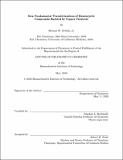New fundamental transformations of heterocyclic compounds enabled by copper catalysis
Author(s)
Gribble, Michael William,Jr.
Download1192965329-MIT.pdf (139.6Mb)
Other Contributors
Massachusetts Institute of Technology. Department of Chemistry.
Advisor
Stephen L. Buchwald.
Terms of use
Metadata
Show full item recordAbstract
Chapter One. Introduction to Catalytic C-C⁻Bond⁻Forming Reactions of Alkylcopper(I) Nucleophiles This chapter provides a brief historical perspective on the development of Cucatalyzed C-C⁻bond-forming reactions and an overview of the general facets of organocopper reactivity that are most important to the work documented in subsequent chapters. Chapter Two: Asymmetric Copper-Hydride-Catalyzed Markovnikov Hydrosilylation of Vinylarenes and Vinyl Heterocycles Copper hydride complexes catalyze highly enantioselective Markovnikov hydrosilylation of vinylarenes and vinyl heterocycles. This method has a broad scope and enables both the synthesis of isolable silanes and the conversion of crude products to chiral alcohols. DFT calculations support a mechanism proceeding by hydrocupration followed by !-bond metathesis with a hydrosilane. Chapter Three: Asymmetric Cu-Catalyzed 1,4⁻Dearomatization of Pyridines and Pyridazines without Preactivation of the Heterocycle or Nucleophile. A chiral copper hydride complex catalyzes C-C bond-forming dearomatization of pyridines and pyridazines at room temperature. The catalytic reaction operates directly on free heterocycles and generates the nucleophiles in situ, eliminating the need for stoichiometric preactivation of either reaction partner; further, it is one of very few methods available for the enantioselective 1,4⁻dearomatization of heteroarenes. Combining the dearomatization with facile derivatization steps enables one-pot syntheses of enantioenriched pyridines and piperidines. Chapter Four: Evidence for Simultaneous Dearomatization of Two Arenes Under Mild Conditions in Cu(I)-Catalyzed Direct Asymmetric Dearomatization of Pyridine Bis(phosphine) copper hydride complexes are uniquely able to catalyze the direct dearomatization of unactivated pyridines with carbon nucleophiles, but the mechanistic basis for this result has been unclear. Here we show that, contrary to our initial hypotheses, the catalytic mechanism is monometallic and proceeds via dearomative rearrangement of the phenethylcopper nucleophile to a Cparametalated form prior to reaction at heterocycle C4. Our studies support an unexpected heterocycle-promoted pathway for this net 1,5⁻Cu⁻migration beginning with a doubly dearomative imidoyl-Cu-ene reaction. Kinetics, substituent effects, computational modeling, and spectroscopic studies support the involvement of this unusual process. The CuL₂ fragment subsequently mediates a stepwise Cope rearrangement of the doubly dearomatized intermediate to give the C4⁻ functionalized 1,4-dihydropyridine, lowering a second barrier in the pathway that otherwise prohibit efficient asymmetric catalysis.
Description
Thesis: Ph. D., Massachusetts Institute of Technology, Department of Chemistry, May, 2020 Cataloged from the official PDF of thesis. Includes bibliographical references.
Date issued
2020Department
Massachusetts Institute of Technology. Department of ChemistryPublisher
Massachusetts Institute of Technology
Keywords
Chemistry.